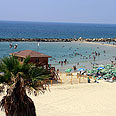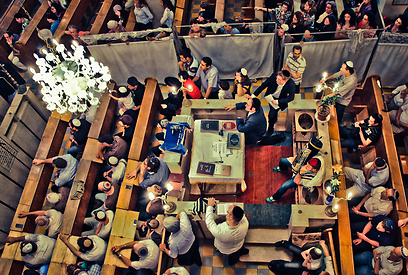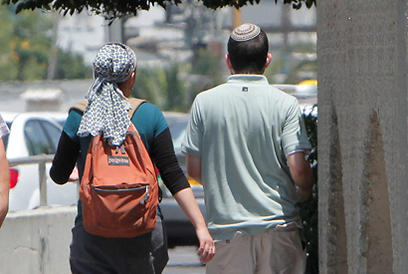&91;1&93;_a.jpg)

From the time Tel Aviv was founded, it has been home to religious residents who comprised an integral part of the first Hebrew city. Early municipal legislation even prohibited cart traffic on Herzl St. on Saturdays, and it was illegal to water one's garden on the day of rest.
Since then, Tel Aviv's religious community has experienced its ups and downs. When the city began "secularizing" in the 1970s, and prices began to rise, observant residents began to leave the city in droves. Those who could afford to stay moved mostly to the Bavli and Nahalat Yitzhak neighborhoods.
Related stories:
- 60 Minutes puts spotlight on 'apathetic TA bubble'
The profound impact of Israel's 2005 disengagement from the Gaza Strip on the national-religious sector, and the realization of how important it was to maintain a dialogue will all sectors of Israeli society, brought many to the understanding that the "State of Tel Aviv" was no less important than the Jewish State.
Acting on that realization, a number of religious groups established themselves in the city in hope of improving secular and observant residents' perceptions of each other, as well as shoring up Tel Aviv's existing synagogues.

The synagogue in old north Tel Aviv (Photo: Tomer Peled, courtesy Motzash)
The main opposition arose from home base, as the religious community in Tel Aviv became concerned that the newcomers were taking over their educational institutions and trying to force them into the national-haredi camp. After a few stormy years, the community arrived at the status-quo: the Moriah school on Zeitlin St. became a national-haredi school in which pupils are segregated by gender, while the Meiron School in north Tel Aviv represents a more moderate approach.
Aviad and Dr. Hannah Friedman moved to Tel Aviv from Gush Etzion with their children.
Aviad says he can see how the number of religious residents of Tel Aviv has grown. "For example, in our first year at the Meiron School there were 14-18 kids in every year. This year my daughter is attending first grade with 54 other children."
"I really love the city, and feel its influence on all my family. We've just finished guiding 12-year-old Hagar through her conversion (to Judaism) – this is something that couldn't have happened in Gush Etzion."
Another thing that couldn't have happened in Gush Etzion was the establishment of the most liberal Orthodox minyan in Tel Aviv, in which the Friedmans were instrumental. The minyan includes a lesbian couple. "Only in Tel Aviv is there a community of religious gays and lesbians," Hannah notes.

More religious people on the streets of Tel Aviv (Photo: Yossi Zeliger, Motzash)
Another important aspect in Tel Aviv's changing religious face is the arrival of European Jews, many from France, many observant. The new immigrants have opened a number of kosher patisseries, boulangeries, and rotisseries, as well as kosher gourmet food stores.
However, with all due respect to idealistic families and new immigrants, the main factor in the religious "inflation" in Tel Aviv is religious singles. The Tel Aviv religious single is usually older, and prefers to live alone. Elad Yana, 32, explains: Tel Aviv is a lot less claustrophobic from a social perspective… friendships here are less sticky and dependent."
"Here, it's natural to go out with friends from work or school, and there's less pressure to spend time just with people from the (religious) sector," Yana adds.
But it comes with a price. "When you're five minutes from the beach, and downstairs there's a pick-up bar, it has an effect – there's nothing you can do about it," says Michal, a 30-year-old observant single woman.
As far as modest dress, Michal says, "Young women allow themselves to dress more provocatively. Shorts, tank tops. Lots of (religious) guys wear kippas on Shabbat only. And 'no physical contact' isn't exactly a prohibition that's observed carefully. I know girls who have things they feel free to do only with secular guys because they're 'out of bounds' when it comes to a shidduch."
Some of the older religious residents look askance at the new generation moving in. There is ambivalence – on one hand, there's less danger of minyans closing down for lack of worshippers. On the other hand, there is a two-generation gap between the old guard and the youngsters, many of whom hold more liberal views.
Rami and Kika Goren, founders of the Kommemiyut Avraham Synagogue, are actively seeking younger members to keep the shul going in the future.
"When we looked at what was happening in the city, we saw that despite the new minyans, there wasn't actually a 'normal' minyan for young people. It was either national-haredim or 'egalitarian' synagogues. We decided to turn to all the young people looking for a 'regular' synagogue and encourage them to join."















